Our intolerance of the people from North-Eastern states runs dangerously deep, especially in cosmopolitan cities. Just what will change our ignorant, dictatorial mindsets?
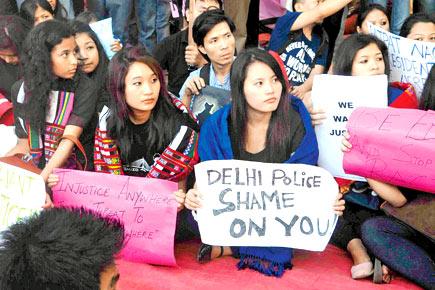
As the sun is about to set on Tuesday, Azad Maidan stands divided. The division is not equal, not by any standard — at least a thousand women and men from the aanganwadis flock toward the gathering to the right. On the left, a group of students and young professionals (still dressed in formals), mainly from Arunachal Pradesh and seven other North-Eastern states take their places under a makeshift canopy. Some solemnly light candles in front of late Nido Tania’s photograph, while others unfold placards amid booming cries of the aanganwadi protestors a few feet away.
ADVERTISEMENT
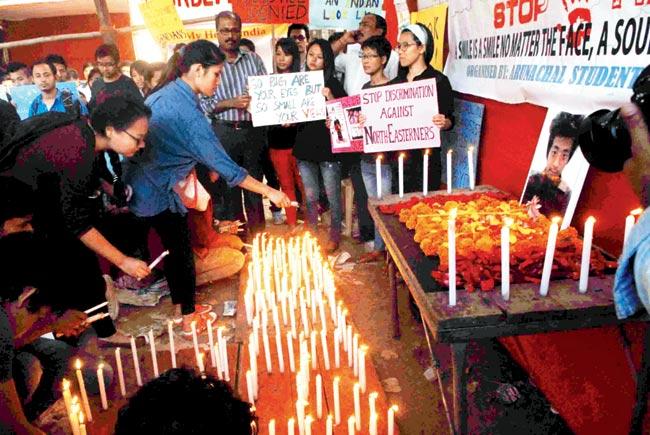
The candlelight gathering to protest the murder of Arunachal Pradesh-born Nido Tania at Azad Maidan. The march mainly comprised students and working professionals from the eight North-Eastern states. Pic/Atul Kamble
‘So big are your eyes, but so small are your views.’ ‘What should an Indian look like?’ ‘Indian, not Chinki.’ ‘Demand inclusion of North-East in national curriculum.’ In many ways, the sight at Azad Maidan is telling of the situation faced by the North-East community spread over the country — a community that constantly feels the need to make its voice heard over the din, protesting rampant harassment and petty name-calling. Why do citizens from the eight North-Eastern states feel compelled to demand their basic right of egalitarianism even in the most cosmopolitan metros?

Students and professionals from the NE states protest against Nido Tania’s death at Azad Maidan. Pics/ Atul Kamble
Ignorance and discrimination, quite shockingly, goes way beyond the layperson calling a North-Easterner ‘chinki’ — even government sources remain grossly misinformed. Delhi-based Abhijit Borah, who will register his organisation, North East India Image Managers this year, tells us how even the Malayalam Manorama Yearbook, 2013 (whose Hindi yearbook had a readership of 2,44,833 last year), got most of its geographical and cultural facts about the North-East wrong. “When we approached them, they said their facts were taken from a government knowledge book in 2011. Asia’s largest open university, the Delhi-based IGNOU, demanded that citizens from Nagaland certify their nationality for admission into its MPhil course. The university didn’t entertain us until we approached the media. Yatra.com, the travel portal, needed you to click on ‘International Flights’ to book a ticket to Imphal, until we intervened. The list is endless.”
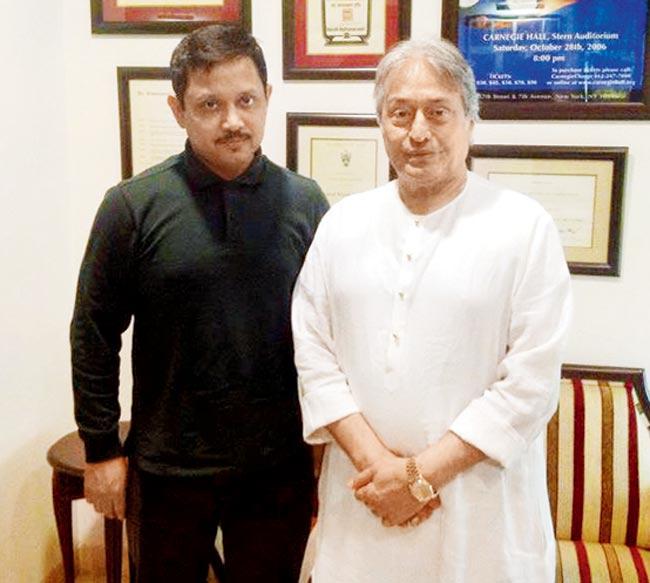
In May, Shyamkanu Mahanta (left) will bring the Sankaradev Movement to Mumbai to acquaint the city with the Assamese philosopher’s culture. Ustad Amjad Ali Khan is the festival’s ambassador
“We are not ‘you people’”
Twenty-seven-year-old Tseten Pame (name changed), does not repeat a single slogan shouted by the protestors at Azad Maidan. She stands with her arms folded, and refuses to speak when she realises this interview is for a newspaper. After almost an hour into the protest, after overhearing our conversations with other protestors, she leans in.
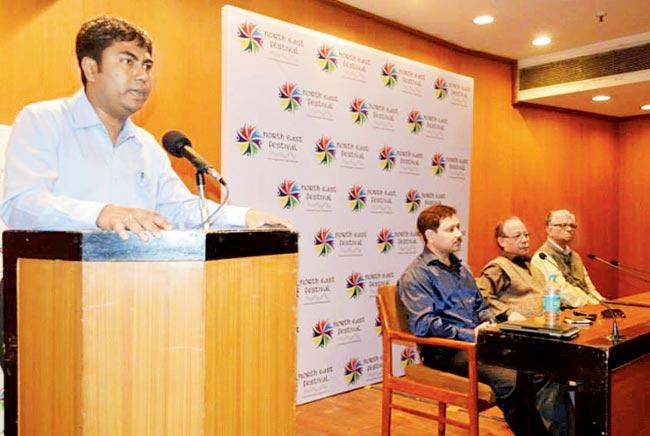
Abhijit Borah (left), co-founder of the North East India Image Managers works towards disseminating more positive news from the North-East
Pame says she works in a government department (she isn’t comfortable revealing its name either because she is the only one from the North-East in her office and can be singled out). “I came here from Manipur two years ago, but I am going back soon. I cannot work here; I refuse to live here. Look at all of us, lighting candles for a boy who was killed for nothing — who deserves this?”
According to Pame, the violence on the North-Eastern community is many-headed and insidious — it isn’t even visible most of the time. The choice, as it goes, is between the devil and the deep sea. “I am trying my best to learn Hindi after coming to the city. But when I try speaking Hindi at work, and it isn’t accurate, my colleagues roll their eyes and exclaim, ‘pagal’. If I do not speak Hindi, they demand, ‘You still cannot speak Hindi living in Mumbai? Pagal ho kya?’” Pame adds that she is often addressed as ‘you people’.
Recently, Pame’s seniors asked her to quit dressing in ‘smart, Western outfits’ because “it was not appropriate”. “I began wearing kurtas,” she says. “Later, I noticed that all the other girls in my office wear Western formals, and when I enquired, there was no dress code,” she says. More harassment, directed at her roots, continues. Her male colleagues often keep a tab on how many male friends she has on Facebook and comment that “she leads a rather exciting life”. “I’ve hidden my friends list now.”
“People should come to the North-East, and see how liberal and welcoming people are. No one there forces you to shut yourself up, cut down on your social life to appease twisted, conservative minds.”
In spite of the attempts by the people from the North-East to be heard and understood, racial discrimination persists in metros such as Mumbai, Delhi and Bangalore. And ironically, the job of turning the situation on its head seems to be saddled on the community itself.
Three solutions
According to Sanjoy Hazarika, director, Centre for North East Studies, Jamia Millia Islamia University in New Delhi, the harassment sprouts an uglier, loutish face in the north than in the west of the country (in Mumbai, for instance). “We need to do three things, just three things to curb the kind of brutish harassment people from the North-East are subjected to. People who are convicted in hate crimes against the North-Easterners must be booked under the Scheduled Castes and Scheduled Tribes (Prevention of Atrocities) Act. The law has been used robustly to protect rights of Dalits in Maharashtra — but the police forgets that the law includes tribes, too.”
Hazarika adds that the police is not currently sensitised about the concerns and the problems of the North-East, which reflects in their treatment of the community. “There is an urgent need for orientation, revisional training and sensitisation programmes. We need to go beyond the pep talk the cops get after a violent incident like Nido’s death.”
Lastly, Hazarika emphasises on the need for better dissemination of information and knowledge about the North-East across the rest of the country. It is not just up to the media, he adds. “There is nothing about the North-East built into school curricula yet. Fiction and non-fiction in the country didn’t touch upon the region — it was just last year that the Delhi University began teaching fiction and non-fiction from the North-East in its Literature course.” Citizens of the eight Indian states, he adds, are not taking things lying down — they are trying to rise above the ignorance, but attitudes which have persisted over centuries will need a concentrated, consistent effort to be eradicated. “How many people know that Arunachal Pradesh has adopted Hindi as its primary state language? Isn’t that indicative of its inclusive nature?” demands Hazarika.
Hazarika draws parallels with the apartheid, wherein the harassed managed to take situation into their own hands and achieved results. “But for that, we need a statesman. What we have in India are not leaders, but political pygmies,” he says
with distaste.
Managing the North-East’s image
This year, Borah plans to bring the North East Festival to Mumbai. Three months ago, Borah and his team, the North East India Image Managers (NEIIM), organised the first edition of the festival at Delhi, and 60 per cent of the attendees were from outside the region.
This year, Borah and his 12-member team at NEIIM will continue working in Mumbai, too. “We formed NEIIM in 2012 in Mumbai, Delhi and Bangalore with one basic realisation — that racism against North-Easterners may or may not be intentional, but what lies underneath is ignorance — which can only be wiped out with better communication. We take that upon ourselves.”
NEIIM comprises communications and media professionals who disseminate positive information about the North-East online and offline. After these professionals came together, the first thing they did was to surf the web to get an idea about what about the North-East was out there. That’s when they found the errors on the websites of IGNOU, in the Malayalam Manorama Yearbook 2013, and on Yatra.com.
In December 2012, NEIIM conducted a survey of 700 top-rung professionals — targeting those who normally have a high media consumption ratio. “The point was to illustrate the ignorance about the North-East, but even we were shocked to find that 89 per cent of the professionals could not name all the eight states, forget their capitals — and these were guys from the IIMs and IITs,” remembers Borah. He adds that NEIIM also works at highlighting positive news stories from the North-East in mainstream newspapers. “We must stop seeing these attacks as a law-and-order problem — they are social problems and the government and police need to deal with them accordingly.”
Rapping a different tune
Last week, 27-year-old Borkung Hrangkhawl rapped to the tunes of change at Cultures Of Peace, an event focussing on the North-East at the city’s Kala Ghoda Arts Festival. Tripura-born Hrangkhawl graduated from writing mushy love songs to those which speak about North-East’s issues at age 16. His debut album will release in December 2014, and speak about his journey from Tripura to Delhi (where he lives), political issues of the North-East, commercialism, and the racism faced by citizens from the North-East. “I am very open to having a Delhiite as part of my band, as long as the artiste is good enough to help earn us a Grammy nomination,” he laughs.
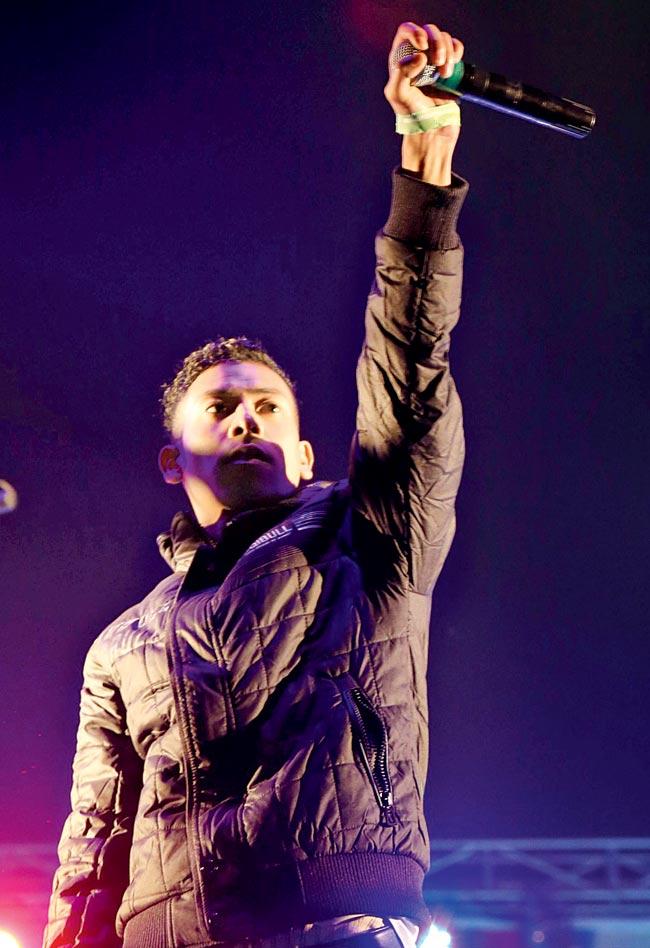
Tripura-born rapper, Borkung Hrangkhawl, at one of his NE tours in 2013
“Most people think all of the North-East is one big, homogenous chunk — it is not. Different tribes have different ways of life. People often ask me what — not where —Tripura is! The North-East is not full of trees, and no, we are not barbarians,” says Hrangkhawl without a hint of humour.
Seven years ago, days after he shifted to Delhi, Hrangkhawl was attacked by two locals who stabbed him repeatedly. “They discussed whether I should be killed or not. One guy said, ‘He’s Nepali, just finish him off’. I clarified that I am from Tripura. At that, they picked me up, gave me a Band-aid for the hole in my chest. They even asked me to come to them if I needed anything.” Hrangkhawl may recount the incident without a trace of terror today, but he adds that he wants his music to do the talking now. “We are changing perceptions we aren’t even responsible for. But someone has to do it, right?” he says.
 Subscribe today by clicking the link and stay updated with the latest news!" Click here!
Subscribe today by clicking the link and stay updated with the latest news!" Click here!







